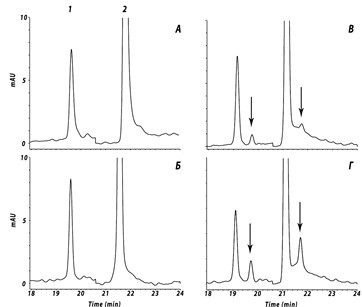THE OPTIMIZATION OF EXTRACTION ROUTINE OF PHOTOSYNTHETIC PIGMENTS AND ITS CONTENT IN LI-CHENS THALLI
Abstract
In this study the way of photosynthetic pigments extraction (chlorophylls and carotinoids) from lichens thalli of two species (Lobaria pulmonaria and Cladonia rangiferina) was optimized. Use of dimethylsulphoxide : acetone (2 : 1) mix, without heating of the pigment extract at 65 °C was recommended. Previous rinsing of thallus by acetone depends on a lichen species and habitat conditions (pollution, etc.). By means of the developed technique the chlorophylls and carotenoids content was defined in 21 different lichen species growing in a middle taiga subzone of the Komi Republic. There are folious and bushy lichens among these species. The lichens were divided into three groups according to photobionts: species with green algae, species with cyanobacteria, and tripartite species with green algal photobionts and cyanobacteria in cephalodia. Across species, significant differences on accumulation of photosynthetic pigments pool was revealed. Thallus chlorophyll concentration ranged 0.4–0.6 mg/g, carotenoids – 0.15–0.30 mg/g in the most of studied lichen species. Photosynthetic pigments, especially chlorophyll a, in the lichens thallus can serve as the important bioindicator on the changing environment conditions and criterion of ecological assessment of habitats. It is important for biomonitoring of the environment and use of lichens as medical materials because of their biochemical structure (pigments, polysaccharides, lichen acids, etc.).
Downloads
Metrics
References
Urbanavichius G.P. Izvestiia RAN. Seriia geograficheskaia, 2011, no. 1, pp. 66–78. (in Russ.).
Pystina T.N., Khermansson Ia. Sovremennaia botanika v Rossii: Trudy XIII S"ezda Russkogo botanicheskogo obshche-stva i konferentsii «Nauchnye osnovy okhrany i ratsional'nogo ispol'zovaniia rastitel'nogo pokrova Volzhskogo bas-seina». [Contemporary Botany in Russia: Proceedings of the 13th Congress of the Russian Botanical Society and the Conference "Scientific Basics of Protection and Rational Use of the Vegetation Cover of the Volga Basin"]. Tol'iatti, 2013, vol. 1, pp. 205–207. (in Russ.).
Zhizn' rastenii. T. 3. Vodorosli. Lishainiki [Life of plants. Vol. 3. Algae. Lichens], ed. M. M. Gollerbakha. Moskva, 1977, 487 p. (in Russ.).
Honegger R. The Mycota. Springer, 2012, vol. IX, pp. 228–339.
Shapiro I.A. Zagadki rasteniia-sfinksa. Lishainiki i ekologicheskii monitoring. [Riddles of the Sphinx plant. Lichens and ecological monitoring]. Leningrad, 1991, 82 p. (in Russ.).
Huneck S., Yoshimura I. Identification of lichen substances. Berlin – Heidelberg – New York: Springer-Verlag, 1996, 493 p.
Wilhelmsen J.B. Bot. Tridss., 1959, no. 55, pp. 20–36.
Hampton E. The Bryologist (short articles), 1973, vol. 76, pp. 543–545.
Lange O.L., Bilger W., Rimke S., Schreiber U. Botanica Acta, 1989, vol. 24, no. 102, pp. 81–92.
Palmquist K., Dahlman L., Valladares F., Tehler A., Sancho L.G., Mattsson J.-E. Oecologia, 2002, vol. 133, pp. 295–306.
Strzalka K., Szymanska R., Suwalsky M. J. Chil. Chem. Soc., 2011, vol. 56, no. 3, pp. 808–811.
Shlyk A.A. Biokhimicheskie metody v fiziologii rastenii [Biochemical methods in plant physiology], ed. O.A. Pavlinovoi. Moskva, 1971, pp. 154–170. (in Russ.).
Wellburn A.R. J. Plant Physiol., 1994, vol. 144, pp. 307–313.
Ra H.S.Y., Geiser L.H., Crang R.F.E. Sci. Total Environ., 2005, vol. 343, pp. 155–167.
Ronen R., Galun M. Environ. Exp. Bot., 1984, vol. 24, pp. 239–245.
Gaaslaa Y., Kopperud C., Solhaug K.A. Lichenologist, 1996, vol. 28, pp. 67–278.
Pfeifhofer H.W., Willfurth R., Zorn M., Kranner I. Protocol in Lichenology. Springer-Verlag: Berlin, Heidelberg, 2002, pp. 363–378.
Gilmore A.M., Yamamoto H.Y. Journal of Chromatography A, 1991, vol. 543, pp. 137–145.
Bolin A.P., Macedo R.C., Marin D.P., Barros M.P., Otton R. Cell Biol. Toxicol., 2010, vol. 26, pp. 457–467.
Tanaka T., Shnimizu M., Moriwaki H. Molecules, 2012, vol. 17, pp. 3202–3242.
Karrpi J., Laukkanen J.A., Mäkikallio T.H., Ronkainen K., Kurl S. Nutrition, Metabolism & Cardiovascular Diseases, 2012, vol. 22 (10), pp. 921–928.
Palmqvist K., Campbell D., Ekblad A., Johansson H. Plant, Cell and Environment, 1998, vol. 21, pp. 361–372.
Golubkova N.S. Novosti sistematiki nizshikh rastenii, 1993, vol. 29, pp. 84–104. (in Russ.).
Golovko T.K., Dymova O.V., Tabalenkova G.N., Pystina T.N. Teoreticheskaia i prikladnaia ekologiia, 2015, no. 4, pp. 38–44. (in Russ.).
Golovko T.K., Dal'ke I.V., Dymova O.V., Zakhozhii I.G., Tabalenkova G.N. Izvestiia Komi nauchnogo tsentra UrO RAN, 2010, no. 1, pp. 39–46. (in Russ.).
Honneger R. Lichen Biology. Cambridge Univ. Press, 2008, pp. 69–93.


This work is licensed under a Creative Commons Attribution 4.0 International License.
The authors, which are published in this journal, agree to the following conditions:
1. Authors retain the copyright to the work and transfer to the journal the right of the first publication along with the work, at the same time licensing it under the terms of the Creative Commons Attribution License, which allows others to distribute this work with the obligatory indication of the authorship of this work and a link to the original publication in this journal .
2. The authors retain the right to enter into separate, additional contractual agreements for the non-exclusive distribution of the version of the work published by this journal (for example, to place it in the university depository or to publish it in a book), with reference to the original publication in this journal.
3. Authors are allowed to post their work on the Internet (for example, in a university repository or on their personal website) before and during the review process of this journal, as this may lead to a productive discussion, as well as more links to this published work.











